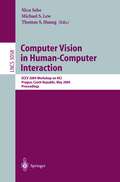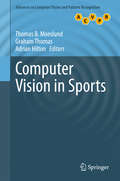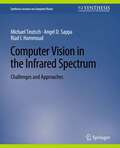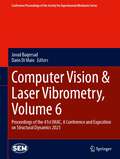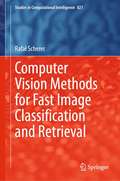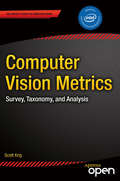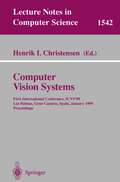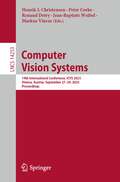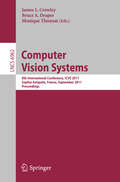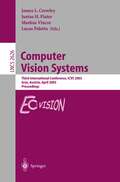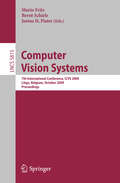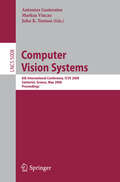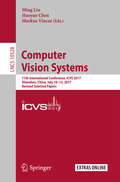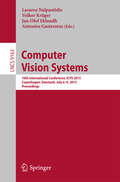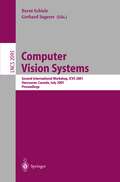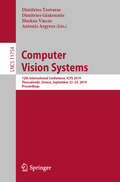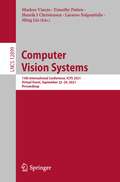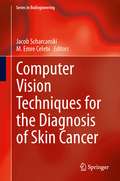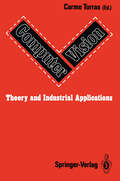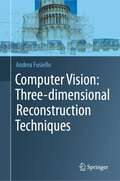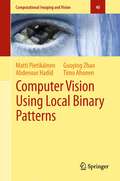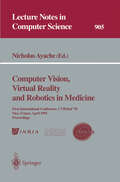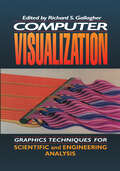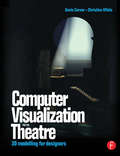- Table View
- List View
Computer Vision in Human-Computer Interaction: ECCV 2004 Workshop on HCI, Prague, Czech Republic, May 16, 2004, Proceedings (Lecture Notes in Computer Science #3058)
by Nicu Sebe Michael S. Lew Thomas S. HuangThis book constitutes the refereed proceedings of the International Workshop on Human-Computer Interaction, HCI 2004, held at ECCV 2004 in Prague, Czech Republic in May 2004. The 19 revised full papers presented together with an introductory overview and an invited paper were carefully reviewed and selected from 45 submissions. The papers are organized in topical sections on human-robot interaction, gesture recognition and body tracking, systems, and face and head.
Computer Vision in Sports (Advances in Computer Vision and Pattern Recognition)
by Thomas B. Moeslund Graham Thomas Adrian HiltonThe first book of its kind devoted to this topic, this comprehensive text/reference presents state-of-the-art research and reviews current challenges in the application of computer vision to problems in sports. Opening with a detailed introduction to the use of computer vision across the entire life-cycle of a sports event, the text then progresses to examine cutting-edge techniques for tracking the ball, obtaining the whereabouts and pose of the players, and identifying the sport being played from video footage. The work concludes by investigating a selection of systems for the automatic analysis and classification of sports play. The insights provided by this pioneering collection will be of great interest to researchers and practitioners involved in computer vision, sports analysis and media production.
Computer Vision in the Infrared Spectrum: Challenges and Approaches (Synthesis Lectures on Computer Vision)
by Michael Teutsch Angel D. Sappa Riad I. HammoudHuman visual perception is limited to the visual-optical spectrum. Machine vision is not. Cameras sensitive to the different infrared spectra can enhance the abilities of autonomous systems and visually perceive the environment in a holistic way. Relevant scene content can be made visible especially in situations, where sensors of other modalities face issues like a visual-optical camera that needs a source of illumination. As a consequence, not only human mistakes can be avoided by increasing the level of automation, but also machine-induced errors can be reduced that, for example, could make a self-driving car crash into a pedestrian under difficult illumination conditions. Furthermore, multi-spectral sensor systems with infrared imagery as one modality are a rich source of information and can provably increase the robustness of many autonomous systems. Applications that can benefit from utilizing infrared imagery range from robotics to automotive and from biometrics to surveillance. In this book, we provide a brief yet concise introduction to the current state-of-the-art of computer vision and machine learning in the infrared spectrum. Based on various popular computer vision tasks such as image enhancement, object detection, or object tracking, we first motivate each task starting from established literature in the visual-optical spectrum. Then, we discuss the differences between processing images and videos in the visual-optical spectrum and the various infrared spectra. An overview of the current literature is provided together with an outlook for each task. Furthermore, available and annotated public datasets and common evaluation methods and metrics are presented. In a separate chapter, popular applications that can greatly benefit from the use of infrared imagery as a data source are presented and discussed. Among them are automatic target recognition, video surveillance, or biometrics including face recognition. Finally, we conclude with recommendations for well-fitting sensor setups and data processing algorithms for certain computer vision tasks. We address this book to prospective researchers and engineers new to the field but also to anyone who wants to get introduced to the challenges and the approaches of computer vision using infrared images or videos. Readers will be able to start their work directly after reading the book supported by a highly comprehensive backlog of recent and relevant literature as well as related infrared datasets including existing evaluation frameworks. Together with consistently decreasing costs for infrared cameras, new fields of application appear and make computer vision in the infrared spectrum a great opportunity to face nowadays scientific and engineering challenges.
Computer Vision & Laser Vibrometry, Volume 6: Proceedings of the 41st IMAC, A Conference and Exposition on Structural Dynamics 2023 (Conference Proceedings of the Society for Experimental Mechanics Series)
by Javad Baqersad Dario Di MaioComputer Vision & Laser Vibrometry, Volume 6: Proceedings of the 41st IMAC, A Conference and Exposition on Structural Dynamics, 2023, the sixth volume of ten from the Conference brings together contributions to this important area of research and engineering. The collection presents early findings and case studies on fundamental and applied aspects of Computer Vision, Laser Vibrometry and Structural Health Monitoring, including papers on:Novel TechniquesOptical Methods,Scanning LDV MethodsPhotogrammetry & DICStructural Health Monitoring
Computer Vision Methods for Fast Image Classification and Retrieval (Studies in Computational Intelligence #821)
by Rafał SchererThe book presents selected methods for accelerating image retrieval and classification in large collections of images using what are referred to as ‘hand-crafted features.’ It introduces readers to novel rapid image description methods based on local and global features, as well as several techniques for comparing images.Developing content-based image comparison, retrieval and classification methods that simulate human visual perception is an arduous and complex process. The book’s main focus is on the application of these methods in a relational database context. The methods presented are suitable for both general-type and medical images. Offering a valuable textbook for upper-level undergraduate or graduate-level courses on computer science or engineering, as well as a guide for computer vision researchers, the book focuses on techniques that work under real-world large-dataset conditions.
Computer Vision Metrics: Survey, Taxonomy, and Analysis
by Scott KrigComputer Vision Metrics provides an extensive survey and analysis of over 100 current and historical feature description and machine vision methods, with a detailed taxonomy for local, regional and global features. This book provides necessary background to develop intuition about why interest point detectors and feature descriptors actually work, how they are designed, with observations about tuning the methods for achieving robustness and invariance targets for specific applications. The survey is broader than it is deep, with over 540 references provided to dig deeper. The taxonomy includes search methods, spectra components, descriptor representation, shape, distance functions, accuracy, efficiency, robustness and invariance attributes, and more. Rather than providing ‘how-to’ source code examples and shortcuts, this book provides a counterpoint discussion to the many fine opencv community source code resources available for hands-on practitioners.
Computer Vision Systems: First International Conference, ICVS '99 Las Palmas, Gran Canaria, Spain, January 13-15, 1999 Proceedings (Lecture Notes in Computer Science #1542)
by Henrik I. ChristensenComputer Vision has now reached a level of maturity that allows us not only to perform research on individual methods but also to build fully integrated computer vision systems of a signi cant complexity. This opens up a number of new problems related to architectures, systems integration, validation of - stems using benchmarking techniques, and so on. So far, the majority of vision conferences have focused on component technologies, which has motivated the organization of the First International Conference on Computer Vision Systems (ICVS). It is our hope that the conference will allow us not only to see a number of interesting new vision techniques and systems but hopefully also to de ne the research issues that need to be addressed to pave the way for more wide-scale use of computer vision in a diverse set of real-world applications. ICVS is organized as a single-track conference consisting of high-quality, p- viously unpublished, contributed papers on new and original research on c- puter vision systems. All contributions will be presented orally. A total of 65 papers were submitted for consideration by the conference. All papers were - viewed by three reviewers from the program committee. Thirty-two of the papers were selected for presentation. ICVS’99 is being held at the Alfredo Kraus Auditorium and Convention Centre, in Las Palmas, on the lovely Canary Islands, Spain. The setting is spri- like, which seems only appropriate as the basis for a new conference.
Computer Vision Systems: 14th International Conference, ICVS 2023, Vienna, Austria, September 27–29, 2023, Proceedings (Lecture Notes in Computer Science #14253)
by Henrik I. Christensen Peter Corke Renaud Detry Jean-Baptiste Weibel Markus VinczeThis volume LNCS 14253 constitutes the refereed proceedings of the 14th International Conference, ICVS 2023, in Vienna, Austria, in September 2023.. The 37 full papers presented were carefully reviewed and selected from 74 submissions. The conference focuses on Humans and Hands; Medical and Health Care; Farming and Forestry; Automation and Manufacturing; Mobile Robotics and Autonomous Systems; and Performance and Robustness.
Computer Vision Systems: 8th International Conference, ICVS 2011, Sophia Antipolis, France, September 20-22, 2011, Proceedings (Lecture Notes in Computer Science #6962)
by James L. Crowley Bruce Draper Monique ThonnatThis book constitutes the refereed proceedings of the 8th International Conference on Computer Vision Systems, ICVS 2011, held in Sophia Antipolis, France, in September 2009. The 22 revised papers presented were carefully reviewed and selected from 58 submissions. The papers are organized in topical sections on vision systems, control of perception, performance evaluation, activity recognition, and knowledge directed vision.
Computer Vision Systems: Third International Conference, ICVS 2003, Graz, Austria, April 1-3, 2003, Proceedings (Lecture Notes in Computer Science #2626)
by James Crowley Justus Piater Markus Vincze Lucas PalettaThis book constitutes the refereed proceedings of the Third International Conference on Computer Vision Systems, ICVS 2003, held in Graz, Austria, in April 2003. The 51 revised full papers presented were carefully reviewed and selected from 109 submissions. The papers are organized in topical sections on cognitive vision, philosophical issues in cognitive vision, cognitive vision and applications, computer vision architectures, performance evaluation, implementation methods, architecture and classical computer vision, and video annotation.
Computer Vision Systems: 7th International Conference on Computer Vision Systems, ICVS 2009 Liège, Belgium, October 13-15, 2009, Proceedings (Lecture Notes in Computer Science #5815)
by Mario Fritz Bernt Schiele Justus H. PiaterThis book constitutes the refereed proceedings of the 7th International Conference on Computer Vision Systems, ICVS 2009, held in Liege, Belgium, October 13-15, 2009. The 21 papers for oral presentation presented together with 24 poster presentations and 2 invited papers were carefully reviewed and selected from 96 submissions. The papers are organized in topical sections on human-machine-interaction, sensors, features and representations, stereo, 3D and optical flow, calibration and registration, mobile and autonomous systems, evaluation, studies and applications, learning, recognition and adaption.
Computer Vision Systems: 6th International Conference on Computer Vision Systems, ICVS 2008 Santorini, Greece, May 12-15, 2008, Proceedings (Lecture Notes in Computer Science #5008)
by Antonios Gasteratos Markus Vincze John K. TsotsosIn the past few years, with the advances in microelectronics and digital te- nology, cameras became a widespread media. This, along with the enduring increase in computing power boosted the development of computer vision s- tems. The International Conference on Computer Vision Systems (ICVS) covers the advances in this area. This is to say that ICVS is not and should not be yet another computer vision conference. The ?eld of computer vision is fully covered by many well-established and famous conferences and ICVS di?ers from these by covering the systems point of view. ICVS 2008 was the 6th International Conference dedicated to advanced research on computer vision systems. The conference, continuing a series of successful events in Las Palmas, Vancouver, Graz, New York and Bielefeld, in 2008 was held on Santorini. In all, 128 papers entered the review process and each was reviewed by three independent reviewers using the double-blind review method. Of these, 53 - pers were accepted (23 as oral and 30 as poster presentation). There were also two invited talks by P. Anandan and by Heinrich H. Bultho ¨ ?. The presented papers cover all aspects of computer vision systems, namely: cognitive vision, monitor and surveillance, computer vision architectures, calibration and reg- tration, object recognition and tracking, learning, human—machine interaction and cross-modal systems.
Computer Vision Systems: 11th International Conference, ICVS 2017, Shenzhen, China, July 10-13, 2017, Revised Selected Papers (Lecture Notes in Computer Science #10528)
by Ming Liu Haoyao Chen Markus VinczeThis book constitutes the refereed proceedings of the 11th International Conference on Computer Vision Systems, ICVS 2017, held in Shenzhen, China, in July 2017. The 61 papers presented were carefully reviewed and selected from 92 submissions. The papers are organized in topical sections on visual control, visual navigation, visual inspection, image processing, human robot interaction, stereo system, image retrieval, visual detection, visual recognition, system design, and 3D vision / fusion.
Computer Vision Systems: 10th International Conference, ICVS 2015, Copenhagen, Denmark, July 6-9, 2015, Proceedings (Lecture Notes in Computer Science #9163)
by Lazaros Nalpantidis Volker Krüger Jan-Olof Eklundh Antonios GasteratosThis book constitutes the refereed proceedings of the 10th International Conference on Computer Vision Systems, ICVS 2015, held in Copenhagen, Denmark, in July 2015. The 48 papers presented were carefully reviewed and selected from 92 submissions. The paper are organized in topical sections on biological and cognitive vision; hardware-implemented and real-time vision systems; high-level vision; learning and adaptation; robot vision; and vision systems applications.
Computer Vision Systems: Second International Workshop, ICVS 2001 Vancouver, Canada, July 7-8, 2001 Proceedings (Lecture Notes in Computer Science #2095)
by Bernt Schiele Gerhard SagererFollowing the highly successful International Conference on Computer Vision - stems held in Las Palmas, Spain (ICVS’99), this second International Workshop on Computer Vision Systems, ICVS 2001 was held as an associated workshop of the International Conference on Computer Vision in Vancouver, Canada. The organization of ICVS’99 and ICVS 2001 was motivated by the fact that the - jority of computer vision conferences focus on component technologies. However, Computer Vision has reached a level of maturity that allows us not only to p- form research on individual methods and system components but also to build fully integrated computer vision systems of signi cant complexity. This opens a number of new problems related to system architecture, methods for system synthesis and veri cation, active vision systems, control of perception and - tion, knowledge and system representation, context modeling, cue integration, etc. By focusing on methods and concepts for the construction of fully integrated vision systems, ICVS aims to bring together researchers interested in computer vision systems. Similar to the previous event in Las Palmas, ICVS 2001 was organized as a single-track workshop consisting of high-quality, previously unpublished papers on new and original research on computer vision systems. All contributions were presented orally. A total of 32 papers were submitted and reviewed thoroughly by program committee members. Twenty of them have been selected for p- sentation. We would like to thank all members of the organizing and program committee for their help in putting together a high-quality workshop.
Computer Vision Systems: 12th International Conference, ICVS 2019, Thessaloniki, Greece, September 23–25, 2019, Proceedings (Lecture Notes in Computer Science #11754)
by Dimitrios Tzovaras Dimitrios Giakoumis Markus Vincze Antonis ArgyrosThis book constitutes the refereed proceedings of the 12th International Conference on Computer Vision Systems, ICVS 2019, held in Thessaloniki, Greece, in September 2019.The 72 papers presented were carefully reviewed and selected from 114 submissions. The papers are organized in the following topical sections; hardware accelerated and real time vision systems; robotic vision; vision systems applications; high-level and learning vision systems; cognitive vision systems; movement analytics and gesture recognition for human-machine collaboration in industry; cognitive and computer vision assisted systems for energy awareness and behavior analysis; and vision-enabled UAV and counter UAV technologies for surveillance and security of critical infrastructures.
Computer Vision Systems: 13th International Conference, ICVS 2021, Virtual Event, September 22-24, 2021, Proceedings (Lecture Notes in Computer Science #12899)
by Markus Vincze Timothy Patten Henrik I Christensen Lazaros Nalpantidis Ming LiuThis book constitutes the refereed proceedings of the 13th International Conference on Computer Vision Systems, ICVS 2021, held in September 2021. Due to COVID-19 pandemic the conference was held virtually. The 20 papers presented were carefully reviewed and selected from 29 submissions. cover a broad spectrum of issues falling under the wider scope of computer vision in real-world applications, including among others, vision systems for robotics, autonomous vehicles, agriculture and medicine. In this volume, the papers are organized into the sections: attention systems; classification and detection; semantic interpretation; video and motion analysis; computer vision systems in agriculture.
Computer Vision Techniques for the Diagnosis of Skin Cancer (Series in BioEngineering)
by Jacob Scharcanski M. Emre CelebiThe goal of this volume is to summarize the state-of-the-art in the utilization of computer vision techniques in the diagnosis of skin cancer. Malignant melanoma is one of the most rapidly increasing cancers in the world. Early diagnosis is particularly important since melanoma can be cured with a simple excision if detected early. In recent years, dermoscopy has proved valuable in visualizing the morphological structures in pigmented lesions. However, it has also been shown that dermoscopy is difficult to learn and subjective. Newer technologies such as infrared imaging, multispectral imaging, and confocal microscopy, have recently come to the forefront in providing greater diagnostic accuracy. These imaging technologies presented in this book can serve as an adjunct to physicians and provide automated skin cancer screening. Although computerized techniques cannot as yet provide a definitive diagnosis, they can be used to improve biopsy decision-making as well as early melanoma detection, especially for patients with multiple atypical nevi.
Computer Vision: Theory and Industrial Applications
by Carme TorrasThis book is the fruit of a very long and elaborate process. It was conceived as a comprehensive solution to several deficiencies encountered while trying to teach the essentials of Computer Vision in different contexts: to technicians from industry looking for technological solutions to some of their problems, to students in search of a good subject for a PhD thesis, and to researchers in other fields who believe that Computer Vision techniques may help them to analyse their results. The book was carefully planned with all these people in mind. Thus, it covers the fundamentals of both 2D and 3D Computer Vision and their most widespread industrial applications, such as automated inspection, robot guidance and workpiece acquisition. The level of explanation is that of an expanded introductory text, in the sense that, besides the basic material, some special advanced topics are included in each chapter, together with an extensive bibliography for experts to follow up. Well-known researchers on each of the topics were appointed to write a chapter following several guidelines to ensure a consistent presentation throughout. I would like to thank the authors for their patience, because some of them had to go through several revisions of their chapters in order to avoid repetition and to improve the homogeneity and coherence of the book. I hope they will find that the final result has been worth their efforts.
Computer Vision: Three-dimensional Reconstruction Techniques
by Andrea FusielloFrom facial recognition to self-driving cars, the applications of computer vision are vast and ever-expanding. Geometry plays a fundamental role in this discipline, providing the necessary mathematical framework to understand the underlying principles of how we perceive and interpret visual information in the world around us. This text explores the theories and computational techniques used to determine the geometric properties of solid objects through images. It covers the basic concepts and provides the necessary mathematical background for more advanced studies. The book is divided into clear and concise chapters covering a wide range of topics including image formation, camera models, feature detection and 3D reconstruction. Each chapter includes detailed explanations of the theory as well as practical examples to help the reader understand and apply the concepts presented. The book has been written with the intention of being used as a primary resource for students on university courses in computer vision, particularly final year undergraduate or postgraduate computer science or engineering courses. It is also useful for self-study and for those who, outside the academic field, find themselves applying computer vision to solve practical problems. The aim of the book is to strike a balance between the complexity of the theory and its practical applicability in terms of implementation. Rather than providing a comprehensive overview of the current state of the art, it offers a selection of specific methods with enough detail to enable the reader to implement them.
Computer Vision Using Local Binary Patterns (Computational Imaging and Vision #40)
by Matti Pietikäinen Abdenour Hadid Guoying Zhao Timo AhonenThe recent emergence of Local Binary Patterns (LBP) has led to significant progress in applying texture methods to various computer vision problems and applications. The focus of this research has broadened from 2D textures to 3D textures and spatiotemporal (dynamic) textures. Also, where texture was once utilized for applications such as remote sensing, industrial inspection and biomedical image analysis, the introduction of LBP-based approaches have provided outstanding results in problems relating to face and activity analysis, with future scope for face and facial expression recognition, biometrics, visual surveillance and video analysis. Computer Vision Using Local Binary Patterns provides a detailed description of the LBP methods and their variants both in spatial and spatiotemporal domains. This comprehensive reference also provides an excellent overview as to how texture methods can be utilized for solving different kinds of computer vision and image analysis problems. Source codes of the basic LBP algorithms, demonstrations, some databases and a comprehensive LBP bibliography can be found from an accompanying web site. Topics include: local binary patterns and their variants in spatial and spatiotemporal domains, texture classification and segmentation, description of interest regions, applications in image retrieval and 3D recognition - Recognition and segmentation of dynamic textures, background subtraction, recognition of actions, face analysis using still images and image sequences, visual speech recognition and LBP in various applications.Written by pioneers of LBP, this book is an essential resource for researchers, professional engineers and graduate students in computer vision, image analysis and pattern recognition. The book will also be of interest to all those who work with specific applications of machine vision.
Computer Vision, Virtual Reality and Robotics in Medicine: First International Conference, CVRMed '95, Nice, France, April 3 - 6, 1995. Proceedings (Lecture Notes in Computer Science #905)
by Nicholas AyacheThis book contains the written contributions to the program of the First In ternational Conference on Computer Vision, Virtual Reality, and Robotics in Medicine (CVRMed'95) held in Nice during the period April 3-6, 1995. The articles are regrouped into a number of thematic sessions which cover the three major topics of the field: medical image understanding, registration problems in medicine, and therapy planning, simulation and control. The objective of the conference is not only to present the most innovative and promising research work but also to highlight research trends and to foster dialogues and debates among participants. This event was decided after a preliminary successful symposium organized in Stanford in March 1994 by E. Grimson (MIT), T. Kanade (CMU), R. Kikinis and W. Wells (Chair) (both at Harvard Medical School and Brigham and Women's Hospital), and myself (INRIA). We received 92 submitted full papers, and each one was evaluated by at least three members of the Program Committee, with the help of auxiliary reviewers. Based on these evaluations, a representative subset of the Program Committee met to select 19 long papers, 29 regular papers, and 27 posters. The geographical repartition of the contributions is the following: 24 from European countries (other than France), 23 contributions from France, 20 from Northern America (USA and Canada), and 8 from Asia (Japan and Singapore).
Computer Visualization: Graphics Techniques for Engineering and Scientific Analysis
by Richard S. GallagherRapid advances in 3-D scientific visualization have made a major impact on the display of behavior. The use of 3-D has become a key component of both academic research and commercial product development in the field of engineering design. Computer Visualization presents a unified collection of computer graphics techniques for the scientific visualization of behavior. The book combines a basic overview of the fundamentals of computer graphics with a practitioner-oriented review of the latest 3-D graphics display and visualization techniques. Each chapter is written by well-known experts in the field. The first section reviews how computer graphics visualization techniques have evolved to work with digital numerical analysis methods. The fundamentals of computer graphics that apply to the visualization of analysis data are also introduced. The second section presents a detailed discussion of the algorithms and techniques used to visualize behavior in 3-D, as static, interactive, or animated imagery. It discusses the mathematics of engineering data for visualization, as well as providing the current methods used for the display of scalar, vector, and tensor fields. It also examines the more general issues of visualizing a continuum volume field and animating the dimensions of time and motion in a state of behavior. The final section focuses on production visualization capabilities, including the practical computational aspects of visualization such as user interfaces, database architecture, and interaction with a model. The book concludes with an outline of successful practical applications of visualization, and future trends in scientific visualization.
Computer Visualization: Graphics Techniques for Engineering and Scientific Analysis
Rapid advances in 3-D scientific visualization have made a major impact on the display of behavior. The use of 3-D has become a key component of both academic research and commercial product development in the field of engineering design. Computer Visualization presents a unified collection of computer graphics techniques for the scientific visualization of behavior. The book combines a basic overview of the fundamentals of computer graphics with a practitioner-oriented review of the latest 3-D graphics display and visualization techniques. Each chapter is written by well-known experts in the field. The first section reviews how computer graphics visualization techniques have evolved to work with digital numerical analysis methods. The fundamentals of computer graphics that apply to the visualization of analysis data are also introduced. The second section presents a detailed discussion of the algorithms and techniques used to visualize behavior in 3-D, as static, interactive, or animated imagery. It discusses the mathematics of engineering data for visualization, as well as providing the current methods used for the display of scalar, vector, and tensor fields. It also examines the more general issues of visualizing a continuum volume field and animating the dimensions of time and motion in a state of behavior. The final section focuses on production visualization capabilities, including the practical computational aspects of visualization such as user interfaces, database architecture, and interaction with a model. The book concludes with an outline of successful practical applications of visualization, and future trends in scientific visualization.
Computer Visualization for the Theatre: 3D Modelling for Designers
by Gavin Carver Christine WhiteTheatre designers using 3D software for computer visualisation in the theatre will find this book both a guide to the creative design process as well as an introduction to the use of computers in live performance. Covering the main software packages in use: Strata Studio Base, 3D Studio Max and 3D Studio Viz, the book provides techniques for 3D modelling alongside creative ideas and concepts for working in 3D space. Projects are provided to sharpen your awareness and digital skills as well as suggested further reading to broaden the scope of your theatrical and design knowledge. This book is both a useful day to day reference as well as an inspirational starting point for implementing your own ideas. The authors are experienced trainers in the field and understand the pitfalls to be avoided as well as the possibilities to be explored using computer visualisation for designing theatre space. They provide insightful hands on descriptions of techniques used in the development of performance projects set in the wider context of design considerations. The book is highly informative about the technology of computer visualisation providing examples of working practice applicable to all software.
